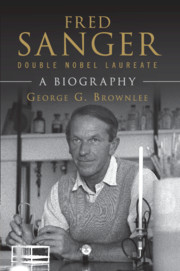Book contents
- Frontmatter
- Dedication
- Contents
- List of figures
- Foreword
- Acknowledgements and original sources
- Brief chronology
- Honours
- Introduction
- 1 A Quaker upbringing
- 2 How about studying insulin?
- 3 Radioactive sequencing of proteins and nucleic acids
- 4 Interview of Fred by the author in 1992: Early life
- 5 Interview of Fred by the author in 1992: Insulin and the Biochemistry Department, University of Cambridge
- 6 Interview of Fred by the author in 1992: Nucleic acids at the MRC Laboratory of Molecular Biology, Cambridge
- 7 Post-Sanger sequencing: high-throughput automated sequencing
- 8 Cancer: the impact of new-generation sequencing
- 9 Commentaries on Fred Sanger’s scientific legacy
- Epilogue
- Appendix: Complete bibliography of Fred Sanger
- Notes
- Index
- Plates
4 - Interview of Fred by the author in 1992: Early life
Published online by Cambridge University Press: 05 November 2014
- Frontmatter
- Dedication
- Contents
- List of figures
- Foreword
- Acknowledgements and original sources
- Brief chronology
- Honours
- Introduction
- 1 A Quaker upbringing
- 2 How about studying insulin?
- 3 Radioactive sequencing of proteins and nucleic acids
- 4 Interview of Fred by the author in 1992: Early life
- 5 Interview of Fred by the author in 1992: Insulin and the Biochemistry Department, University of Cambridge
- 6 Interview of Fred by the author in 1992: Nucleic acids at the MRC Laboratory of Molecular Biology, Cambridge
- 7 Post-Sanger sequencing: high-throughput automated sequencing
- 8 Cancer: the impact of new-generation sequencing
- 9 Commentaries on Fred Sanger’s scientific legacy
- Epilogue
- Appendix: Complete bibliography of Fred Sanger
- Notes
- Index
- Plates
Summary
Fred Sanger (FS) and I (GB) are seated in a recording studio at Imperial College, London. This is a slightly edited transcript of the first interview.
GB Those of us who have worked with you, Fred, know of your passion and vision for research and your interest in developing new methods. We also know you chose important scientific problems that were well ahead of their time. Less well known, but by no means less important, is your ability to get on with colleagues and students. You guided by example, not by dominating people, always encouraged and rarely criticising. You had, I suspect, a respect for people. You have a disarming natural modesty, rare in one so eminent.
For this reason many people, including me, would like to know something of your background, your parentage, your schooling and early influences.
FSI was born in 1918 and brought up in Gloucestershire, in a small Gloucester village, Rendcomb, in the Cotswolds, a very nice part of the world to live in. My father was the local doctor; he was a medical doctor. We have a picture of him here (Figure 1, left). Here is a picture of me (Figure 1, right) at about the same time, 1918, being held by my grandfather, Theodore Crewdson, on my mother’s side, and another picture of me, 8 months old (Figure 2).
- Type
- Chapter
- Information
- Fred Sanger - Double Nobel LaureateA Biography, pp. 40 - 67Publisher: Cambridge University PressPrint publication year: 2014

